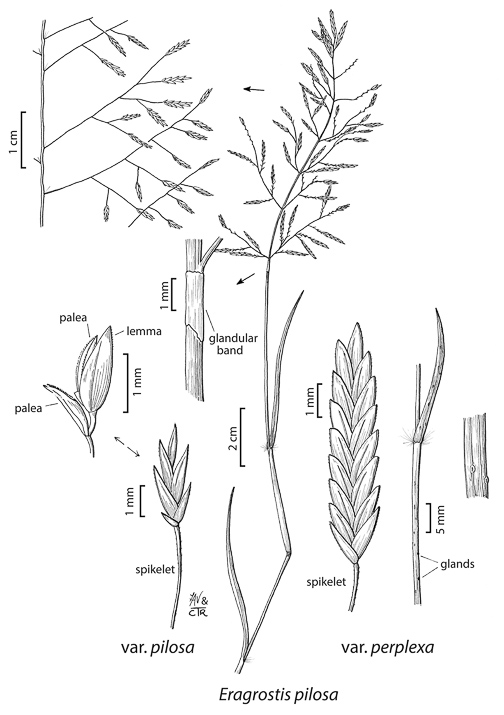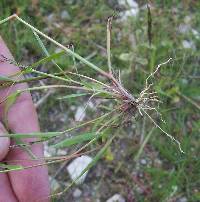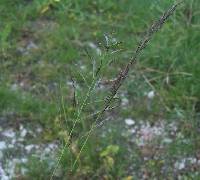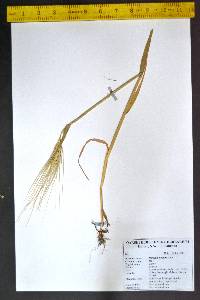|
|
|
|
Family: Poaceae
[Poa pilosa L.] |
Paul M. Peterson Plants annual; tufted, without innovations. Culms 8-45(70) cm, erect or geniculate, glabrous, occasionally with a few glandular depressions. Sheaths mostly glabrous, occasionally glandular, apices hirsute, hairs to 3 mm; ligules 0.1-0.3 mm, ciliate; blades 2-15(20) cm long, 1-2.5(4) mm wide, flat, abaxial surfaces glabrous, occasionally with glandular pits along the midrib, adaxial surfaces scabridulous. Panicles 4-20(28) cm long, 2-15(18) cm wide, ellipsoid to ovoid, diffuse; primary branches 1-10 cm, diverging 10-80° (110° ) from the rachises, capillary, whorled on the lowest 2 nodes, rarely glandular; pulvini glabrous or hairy; pedicels 1-10 mm, flexible, appressed or divergent. Spikelets (2)3.5-6(10) mm long, 0.6-1.4 mm wide, linear-oblong to narrowly ovate, plumbeous, with (3)5-17 florets; disarticulation acropetal, paleas tardily deciduous, rachillas persisting longer than the paleas. Glumesnarrowly ovate to lanceolate, hyaline; lower glumes 0.3-0.6(0.8) mm; upper glumes 0.7-1.2(1.4) mm; lemmas 1.2-1.8(2) mm, ovate-lanceolate, membranous to hyaline, grayish-green proximally,reddish-purple distally, lateral veins inconspicuous, apices acute; paleas 1-1.6 mm, membranous to hyaline, keels scabridulous to scabrous, apices obtuse; anthers 3, 0.2-0.3 mm, purplish. Caryopses 0.5-1 mm, obovoid to prism-shaped, adaxial surfaces flat, smooth to faintly striate, light brown. 2n = 20 [A. Murin, Z. Svobodová, J. Májovský, and V. Feráková. 1999. Chromosome numbetrs of some species of the Slovak flora. Thaiszia 9:31-40], 40. Eragrostis pilosa is native to Eurasia but has become naturalized in many parts of the world. In the Flora region, it grows in forest margins and disturbed sites such as roadsides, railroad embankments, gardens, and cultivated fields, at 0-2500 m. The Morton Arboretum Annual tufted herb 8 cm - 0.73 m tall Leaves: with mostly hairless and sometimes glandular open sheaths that have stiff-haired (to 3 mm long) tips, and 0.1 - 0.3 mm long ligules with hairs along the margins. The blades are 2 - 20 cm long, 1 - 4 mm wide, flat, hairless and sometimes glandular-pitted along the midvein beneath, minutely rough above. Inflorescence: terminal, branched (panicle), rising above upper leaves, 4 - 28 cm long, 2 - 18 cm wide, elliptic to ovoid, with primary branches that are 1 - 10 cm long, rarely glandular, and whorled on the lowest two nodes. Fruit: a light brown caryopsis, 0.5 - 1 mm long, inversely egg-shaped to prism-shaped, flattened on the surface facing the stem, smooth to lightly longitudinally lined but not grooved. Culm: 8 - 45 cm long, erect or sometimes with abrupt bends at the nodes (geniculate), hairless, sometimes with a few glands. Spikelets: on a flexible stalk 1 - 10 mm long, lead-colored, 2 - 10 mm long, 0.6 - 1.4 mm wide, linear-oblong to narrow egg-shaped, laterally compressed. Glumes: transparent, narrow egg-shaped to lance-shaped, single-veined, neither lobed nor awned, with the lower glume 0.3 - 0.8 mm long and the upper glume 0.7 - 1.4 mm long. Florets: three to seventeen per spikelet, with three purplish anthers 0.2 - 0.3 mm long. Lemma: grayish green near the base, reddish purple near the tip, 1.2 - 2 mm long, narrow egg-shaped with a pointed tip, membranous to transparent, usualy hairless, with inconspicuous lateral veins. Palea: 1 - 1.6 mm long, membranous to transparent, with a blunt tip and two rough to minutely rough longitudinal ridges. Similar species: Eragrostis cilianensis, Eragrostis frankii, Eragrostis minor, Eragrostis pectinacea, and Eragrostis pilosa are annuals that lack grooved caryopses (E. frankii sometimes has a shallow groove). Eragrostis cilianensis has wider (2 - 4 mm) and longer spikelets (6 - 20 mm), ten to 40 florets, and three yellow anthers. Eragrostis frankii is easily distinguished by its far fewer florets (three to six), E. minor has two reddish brown anthers, and E. pectinacea has wider (1.2 - 2.5 mm) spikelets and inflorescence branches that are usually solitary or paired at the lowest two nodes. Flowering: July to September Habitat and ecology: Introduced from Europe, this species grows in waste ground. Occurence in the Chicago region: non-native Etymology: Eragrostis is derived from the name of the Greek god of love, Eros, and agrostis, meaning grass. Pilosameans hairy.
Author: The Morton Arboretum Vascular Plants of NE US and adjacent Canada Annual 1-6 dm, erect or ascending from a decumbent base; lvs 1-3 mm wide; sheaths shorter than the internodes; infl 5-20 cm, ellipsoid to ovoid, diffusely branched, the branches at one of the two lowest nodes commonly whorled, seldom merely fascicled or paired; pedicels appressed to more often spreading; spikelets 5-17-fld, 1-2 mm wide; first glume 0.3-0.8 mm, less than half as long as the lowest lemma; lemmas 1.2-1.8 mm, individually deciduous from the persistent rachilla; paleas nearly always deciduous, sometimes only tardily so; grain pyriform to slightly compressed, 0.5-0.9 mm; 2n=40. Pantropical weed, extending n. in our range to Me., Mich., Wis., and Mo. Ours is var. pilosa. (E. multicaulis; E. peregrina) Gleason, Henry A. & Cronquist, Arthur J. 1991. Manual of vascular plants of northeastern United States and adjacent Canada. lxxv + 910 pp. ©The New York Botanical Garden. All rights reserved. Used by permission. |






